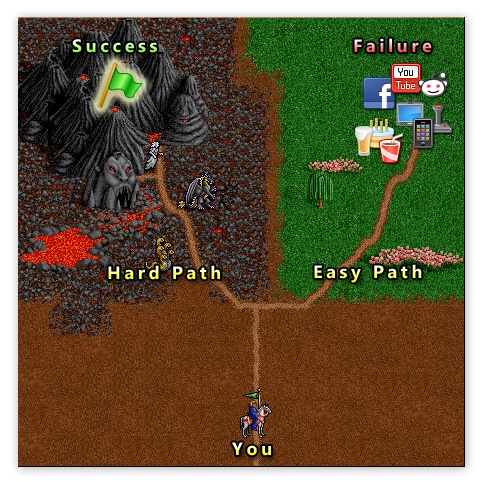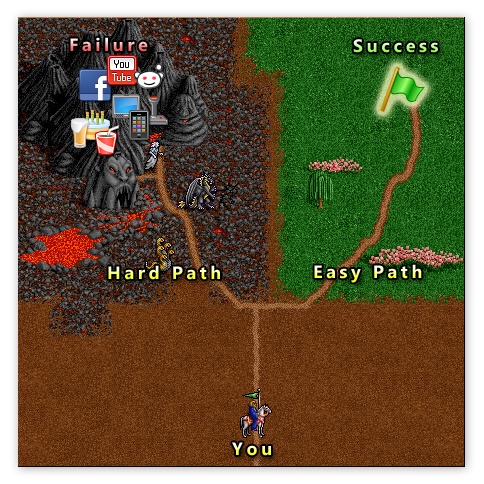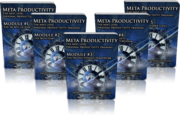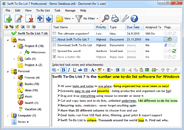Is the following familiar to you?
You set a goal, or take on a new project. You are excited! But soon you discover that your progress is, frankly, a joke. If you are getting closer to achieving your goal or finishing your project at all, your progress is SO-DAMN-SLOW than it COULD have been! You know it, but you just CAN’T get yourself to take the right actions necessary for success.
You are both the grand visionary and architect of your life, and your worst enemy that sabotages your dreams.
Why is that?
You have two brains: A rational brain and a caveman brain (also known as “reptile” brain).
The rational brain wants you to achieve that goal or project.
Caveman brain wants you to pig out, watch TV, play games, surf the web, read news and lay around.
The bad news is that until you learn to co-operate with your caveman brain, you will never be successful. It will sabotage your best efforts when you set goals, it will slow your progress when working on an important project, and when you want to diet – oh Lord – it will stuff your face with asinine amounts of food with 150% of jolly-saturated fat.
The good news is that the rational brain is much smarter than the caveman brain. Better yet, I will show you exactly how you can outsmart the caveman brain and succeed.
It’s all about stacking the deck in your favor. Here, let me show you what I mean:
Before Stacking the Deck for Success

After Stacking the Deck for Success

Unless you love partying with black dragons, hydras, ghosts, and the smell of fresh lava, you are more likely to succeed in the environment “After Stacking the Deck”. So, how to do it? Well, my friend, read on! I promise we will have some fun too ;-)
When it comes to achieving your dreams and goals, this might be the most important thing you will ever learn. If you have trouble with focusing, I urge you to close everything else to make sure you finish this – because this can change your life.
I’ve discovered lot of these concepts by studying behavioral psychology and the science of success, yet I kept only what has worked for me personally and ruthlessly eliminated everything else. It took me over 8 years of experimenting to figure out this stuff. It’s tested and it works. It will work for you, too.
And by the way, the caveman brain is not always our enemy. We need the caveman brain. Not just to pig out, but to survive in dangerous situations, avoid accidents, and dodge huge boulders rolling on us in narrow corridors.
The problem: You know WHAT, you know HOW, but you don’t know HOW TO MAKE YOURSELF DO IT.
You know exactly how to accomplish your goal, because you know the actions to take to accomplish your goal. That’s not the problem! After all, knowing this is rather easy: It doesn’t matter how epic or big your project is, you can just break it down into smaller tasks. A few hours of thinking/writing, tops, and you have a very detailed action plan.
Even if you don’t know all of the action steps, you surely know the first few steps that will move you closer to success; and by taking these steps, you will quickly discover the rest of the steps.
So you already know everything you need to do now, but you don’t know how to make yourself do it. The problem is entirely in the execution.
What is NOT the solution
- You don’t need to rely on motivation. Don’t make the same mistake as I once did and focus just on motivating yourself. It is far better to focus on taking action! Once I stopped worrying about motivating myself and focused on taking massive action instead, my productivity went supernova. When you start taking action successfully, motivation will always come as a result. Just make sure that your goal is something that YOU really want.
- You don’t need to rely on willpower. There is a body of conflicting research on whether willpower is a limited resource or not, but for our purposes, it doesn’t matter! By stacking the deck in your favor, you won’t need to rely on willpower. Betting on willpower is unreliable. You need the willpower just for stacking the deck – and that doesn’t require that much of it.
What IS the solution
- You need to outsmart yourself to make yourself do it.
- You need to discover and fix your Failure Patterns.
- You need to stack the deck in your favor.
- You need to take massive action. Once the deck is stacked in your favor, it will be a breeze. Heck, the caveman brain will enjoy himself by actually helping your rational brain!
Two Behavior Patterns
Every time you say to yourself that you will do something (“Intention for action”), one of the following will happen:
The Success Pattern:
- Intention for action=> Action => Success!
The Failure Pattern:
- Intention for action => Caveman brain feels threatened or has a “better” idea => Different action => Failure!
Perhaps the “different action” was pleasant, but the end result is that you feel like crap for failing – again.
What you must do is to fix the behavioral Failure Patterns in your life and transform them into Success Patterns, one pattern at a time.
That way, the rational brain will be at the helm. You will finally be in control.
How do you fix the Failure Patterns? There are several ways. The optimal way depends on the particular pattern and situation.
Let me give you an example from my own life.
Example of Fixing Failure Pattern in My Life: Waking Up Early
I wanted to become an early riser, and get up at 7 AM or sooner. I was already waking up early, but every time I woke up, I looked at the clock, and if it was “too early” (e.g. anything before 8 AM), I wanted to sleep some more. So I did. Mind you, I was not really tired. It was just “too early” for my caveman brain. Sleeping some more actually made me tired. Long story short, I continued to get up at 9 AM or so. Not cool.
But once I realized what is going on, I was able to instantly fix this Failure Pattern:
- Goal: Get up at 7 AM or sooner each day.
- Actions necessary: First, make sure I wake up before 7 AM, either by going to sleep soon enough, or by setting an alarm clock. Second, get up immediately after waking up.
- The Failure Pattern: I wake up at 6 AM => the caveman brain sees the clock, feels threatened, and wants me to sleep some more => I sleep some more => I get up at 9 AM, feeling tired.
- The solution: Before going to bed, I turn the digital clock to face the wall so I can’t see it.
- The new Success Pattern: I Wake Up => I can’t see the clock, but because I feel well rested, the caveman brain doesn’t feel threatened and assumes I have slept enough => I get up. It’s 6 AM and I feel great!
- Stacking the deck in my favor even more: I don’t eat after 7 PM, so I need less sleep. I make sure the blinds are up when I go to bed, so there is natural light in the morning. I make sure I am warm in the morning. After getting up, I immediately open the window, breathe deeply and look into the light to energize myself. Then, I jump on my mini-rebounder for 5 minutes while thinking about my goals and getting energized and excited about the new day.
The solution, in my case, was to break the Failure Pattern by eliminating the source of undesired behavior. Seeing the early time on the clock was a trigger for caveman brain to take over and make me sleep in. It was a perfect excuse. Eliminating the clock eliminated the trigger for undesired behavior.
Then, I stacked the deck in my favor even more, to absolutely conquer this goal. There is no chance of me sleeping late now. I LOVE GETTING UP EARLY! The excitement and energy feels great to the caveman brain too – remember, the caveman brain is all about positive emotions and good feelings. This is the co-operation you should aim for.
Life-hack tip: While jumping on the rebounder in the morning, or while walking to the office, I often listen to my own custom “motivational” tape (in mp3) that I got produced professionally for $5 dollars. It reminds me about my goals and floods me with positive emotions for the day. It invokes tremendous enthusiasm and desire for action in me. I will talk about getting your own completely custom motivational tape for $5 in a blog post that is coming soon. If you don’t want to miss it, subscribe: G+, Facebook, twitter.
How To Turn Your Failure Patterns into Success Patterns
By seeing my example, you might already have some ideas of how to fix the Failure Patterns. Let’s look at it -
First, you need to be intelligent and observant enough to discover and understand your own Failure Patterns. That might be a bit tricky, as these patterns are often unconscious, but now that you know what to look for, you can do it.
Second, you need to be creative in breaking your Failure Patterns and transforming them into Success Patterns. This is the fun part!
Third, you need to stack the deck in your favor some more, to make the success inevitable. This is fun, too!
Where to look for Failure Patterns? Whenever you want to do something, but end up not doing it, or doing it late, or doing it badly, look for Failure Pattern. Whenever you wonder where the time went by and how you ended up not doing anything again, look for Failure Pattern.
So the whole process looks something like this:
- Pick a goal that you really want.
- Make a quick action plan so you know the steps to achieve your goal.
- Start with the first step immediately.
- Take massive action and observe what’s going on – both in your thoughts and behavior.
- Discover Failure Patterns.
- Once discovered, break the Failure Patterns. Stack the deck in your favor as much as possible to transform them into Success Patterns.
- Go back to 4, repeat until the goal is achieved.
How to Stack the Deck in Your Favor for Inevitable Success
The easiest and most powerful way of eliminating Failure Patterns is by changing the environment. Changing the environment is by far the easiest way how you can stack the deck in your favor. It’s easy, because caveman brain doesn’t feel threatened when you change the environment, so it won’t sabotage the changes. That is your leverage.
Remember, the caveman brain will always choose the easy path. And as shown in the images at the beginning of this post, we can exploit that!
Changing the environment is just one possibility. Your situation is unique. You need to discover strategies that will work best for you. Before you cry out “Lame!” – here is a BUNCH of ideas to get you started. This is what I would do (or already do).
A) Make it harder to do the wrong thing
- Watch too much TV? Turn the TV around to face the wall. Unplug it. Or just give it away!
- Spend too much time on some website? Block it. Better yet, redirect that website to your own HTML file with list of your goals and the next action you need to take now. You can easily create this in any word processor.
- Eat too much junk food? Throw away all junk food and make a COMMITED DECISION that you won’t buy it again. Also make a decision that you won’t shop when hungry. If you fail and shop when hungry, don’t buy the junk food! If you fail and do buy it, throw it in the thrash on your way home [I actually did that once]. If you fail in that too, throw it in the trash later at home. If you fail in that too, then just don’t eat it. Now you have to fail FIVE times in a row to do the wrong thing. Before, all you had to do was to fail ONCE and eat it.
- Check email too often? Make your email client forget the password so it forces you to manually retype it every time. Move the shortcut for the mail client into some obscure location.
- Play too much PC games? Uninstall the games. Sell the DVDs. Cancel your accounts. [I once sold my account in a MMORPG game for a laughable amount, and it was one of the best things I've ever done. Since then, I never played any MMORPG again.] Too hardcore? Then at least use some parental control software on yourself to limit the time when you can play the games. Then – and I don’t care what it takes – substitute the game playing with taking action towards your goals! If you love games, in what ways could you gamificate your life?
- Procrastinate too much? Write baby-steps for your top action. Work just 5 seconds on the first micro baby-step if you must. BUT TAKE ACTION! RIGHT NOW! It’s ridiculous not to take a 5 second action! How hard is to procrastinate on that? Very. Clean your plate so there is nothing else you can do. Die of boredom or do that 5 second action.
- Sleep in instead of waking up early? Setup 3-5 different alarm clocks. Tell your lover to kick you out of the bed and take your blanket in the morning. (Hey, I told you this is fun!)
- Always forget that you want to do something important for you in the morning? Close your laptop and turn it upside down, so the next day, you remember: “A-ha, I wanna do that thing first!” Or, place a chair in your way from the bedroom. Break the Failure Pattern by any means necessary!
- Eat at night? I would suggest locking the fridge, but most fridges can’t be easily locked, and turning the fridge around is not very convenient either – but it would certainly interrupt the eating pattern :-) Maybe a frakking scary boogeyman in the fridge with a loud car horn would do the trick for you!
B) Make it easier to do the right thing
This is mainly about removing obstacles and adding as much convenience as possible.
- Want to run each morning? Prepare your running gear before going to bed, so you see it immediately after waking up and can put it right on. Then go for a walk to enjoy the crisp morning air [caveman brain won't protest – after all, it feels good!]. Then run.
- Want to go to the gym regularly? Hire a personal trainer. You won’t be overwhelmed when you arrive at the gym and see 1000 machines. The personal trainer will tell you exactly what to do and how. He will adjust the machines and weight. (Personal trainer has many other benefits too – for one, you will know you are doing the exercises right.)
- Want to finish your project? Schedule a time just for your project in which you can’t be interrupted. Create an action plan with all the steps for finishing your project, so you always know the next step. Make sure that you always know the next step. Write it on paper and place beside your computer.
- Want to eat light before going to bed? Make sure you always have an early satiating dinner – so you are not hungry later. Make sure you are not bored in the late evening, but fully engaged in something exciting.
C) Make it painful to do the wrong thing
You can also make it so that if you do the wrong thing, it will have painful consequences.
For example, as I described in Achieving goals like a Mad Klingon, you can promise your best buddy that you will give him $1000 if you won’t do X. Talk about leverage!
As far as your caveman brain is concerned, it will be more painful to part with $1000 than to do the action X. After all, do you have any idea how many bacon flavored marshmallows you could buy for $1000?!
D) Eliminate distractions
Being the spontaneous dude he is, the caveman brain loves distractions, So… make sure there aren’t any!
Why are distractions so horrible? Here is a hint:
- Intent for action => Distraction => Entirely different action => Failure!
Distraction equals destruction. Distractions are pure poison. They rob you of your life and potential.
Declare full scale war on distractions. Show no mercy.
Simplify and unclutter your workspace.
Simplify and unclutter your computer desktop – and for crying out loud, disable all notifications!
E) Eliminate commitments to irrelevant projects and people
You can do few things right or many things badly.
Clean your plate. Unburden your load.
Drop as much irrelevant commitments as possible. Decide that you will NOT do.
Commitments that are not aligned with your goals are nothing but distraction factories.
F) Train Focus
Focus alone can’t save you – but it sure as hell helps!
Focusing makes it harder to get distracted, helps you to avoid the mental burden of context switching, and increases the likelihood of finishing any action successfully from beginning to the very end.
I’ve described a simple yet powerful way of focusing when working on the computer in my post Are You a Zen Coder or Distraction-Junkie?
G) ALWAYS have a PAPER to-do list in front of you with the NEXT action
Before going to sleep (= leveraging the subconscious mind), prepare a paper list of actions for the next day that you MUST do the next day (= leveraging focus).
Place it on your desk (= leveraging the environment.) You can start with just 1 or 2 actions, and ramp it up over time. After waking up, immediately begin working on the first action (= leveraging the peak state of the freshly rebooted mind)
If you do this, your day will be completely different. How different? Successful different.
More on this in Be Successful First Thing in the Morning and Seriously, Stop Sabotaging Your 2012 Goals.
H) Have a list of goals on your wall
We need to constantly re-focus. Every time you focus on your goals, it will push other distracting thoughts out of your mind (at least a little bit).
Print your goals and post them on the wall. Read the list once or twice daily. I read mine after waking up, and before going to sleep.
I) Manage your emotional state
It’s hard to be successful when you are lethargic or angry. But you CAN control your emotions. How? Take actions that are INCOMPATIBLE with any negative emotions you might be feeling. Move. Jump. Dance. Walk. Run. Smile. And then, TAKE ACTION! Believe me; taking the right action WILL make you happy. Being successful will make you blissful.
J) Get Creative and Do Something Else
Your situation is unique. You need to get creative, and whatever it takes, break the Failure Patterns. Stack the deck in your favor as much as possible.
Summary
You have two brains: Rational brain and caveman brain.
The caveman brain prefers instant gratification over long-term success. By stepping in, the caveman brain slows or halts our progress towards your goals set by the rational brain.
You need to learn how to outsmart the caveman brain and cooperate with him.
There are two behavioral patterns that humans executes all the time:
- The Success Pattern: Intention for action => Action => Success!
- The Failure Pattern: Intention for action=> Caveman brain doesn’t like and has a better idea => Different action => Failure.
You need to break the Failure patterns and transfer them into the success pattern. To do that, we have to be creative and stack the deck in our favor, by making the success easy and failure hard.
You can stack the deck in your favor by:
- Making it harder to do the undesired behavior
- Making it easier to do the desired behavior
- Making it painful to do the undesired behavior (e.g. by making a significant commitment to others and placing cash on the line)
- Eliminating distractions
- Eliminating commitments to irrelevant projects and people
- Training focus
- Always having a paper to-do list in front of you, and writing tasks for the next day the day before
- Having a list of goals on the wall so you can constantly re-focus
- Managing your emotional state by taking actions incompatible with negative emotions
- Being creative and breaking the Failure Pattern by any means necessary
The whole process of achieving goals by outsmarting yourself for success works like this:
- Pick a goal that you really want.
- Make a quick action plan so you know the steps to achieve your goal.
- Start with the first step immediately.
- Take massive action and observe what’s going on – both in your thoughts and behavior.
- Discover Failure Patterns.
- Once discovered, break the Failure Patterns. Stack the deck in your favor as much as possible to transform them into Success Patterns.
- Go back to 4, repeat until the goal is achieved.
Now it’s your turn!
If you’ve read this far, you are determined to succeed. So put this in action!
What are some of the Failure Patterns in your life? How do you plan to fix them? Post in comments below.
Subscribe: G+, Facebook, or twitter
And if you want to make my day, link to this post and/or to www.dextronet.com. Thank you.
About the author
Jiri Novotny+ has started programming when he was 7, and gotten interested in personal development at 14. He reads 40-50 books a year, and always does crazy experiments to improve and grow.
Jiri is the author of Swift To-Do List 7. His ongoing goal is to create the best task and notes organizer for Windows.
Jiri’s life purpose is help others reach their full potential.
Related Posts:
 Chuck Gallozzi has been using Swift To-Do List for over 7 years. He has written a review of it for his Personal Development newsletter, but he has also sent us a copy to publish on our website. Chuck Gallozzi is personal development expert, prolific writer, certified NLP Practitioner, speaker, seminar leader, and coach. Chuck is the Founder and Head of the Positive Thinkers Group that has been meeting at St. Michael’s Hospital, Toronto since 1999. He is the author of a book “The 3 Thieves and 4 Pillars of Happiness”. We are proud to have Chuck among our satisfied customers. In the past, we’ve also published a review by Chris Engelsma, who has shared his thoughts on why is Swift To-Do List better than web-based organizers, and review by Darryl Benjamin.
Chuck Gallozzi has been using Swift To-Do List for over 7 years. He has written a review of it for his Personal Development newsletter, but he has also sent us a copy to publish on our website. Chuck Gallozzi is personal development expert, prolific writer, certified NLP Practitioner, speaker, seminar leader, and coach. Chuck is the Founder and Head of the Positive Thinkers Group that has been meeting at St. Michael’s Hospital, Toronto since 1999. He is the author of a book “The 3 Thieves and 4 Pillars of Happiness”. We are proud to have Chuck among our satisfied customers. In the past, we’ve also published a review by Chris Engelsma, who has shared his thoughts on why is Swift To-Do List better than web-based organizers, and review by Darryl Benjamin.







